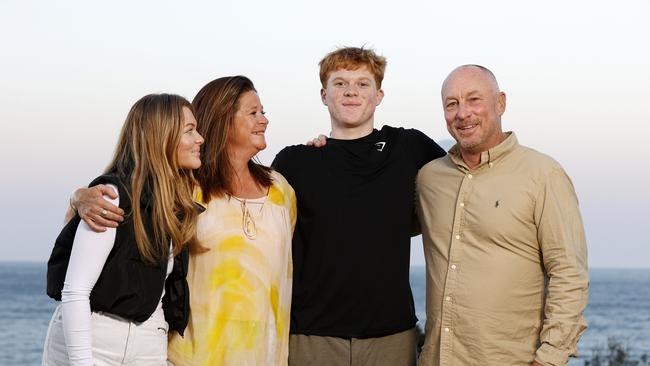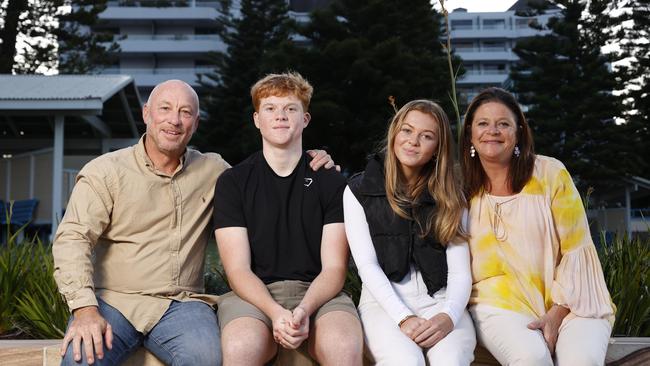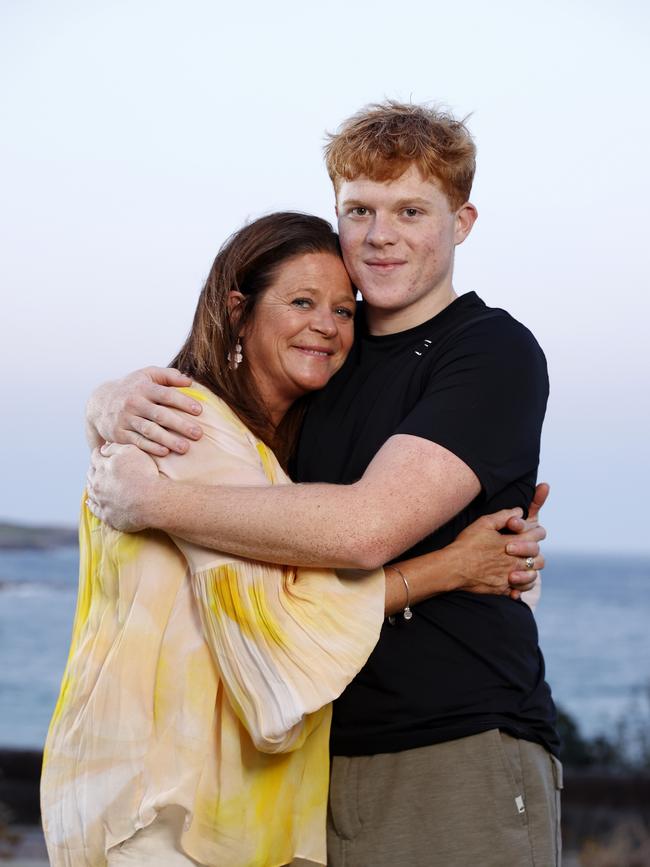Cardiologists, survivors push for mandatory defibrillators in NSW schools after teen’s cardiac arrest
South Coast teen and cardiac arrest survivor Tom Haynes wouldn’t be alive today if his school wasn’t one of the minority to buy a defibrillator. His family says it’s time for the government to step in.

NSW
Don't miss out on the headlines from NSW. Followed categories will be added to My News.
Cardiologists, health experts and cardiac arrest survivors have rallied to call on the government to fund defibrillators for all NSW schools amid revelations fewer than one in three regional schools have one of the lifesaving devices on site.
South Coast teen Tom Haynes is one of the lucky ones. His family say the 17-year-old wouldn’t be alive today if his school, the Carroll College Catholic school in Broulee, hadn’t bought an automated external defibrillator (AED) for the front office.
For Tom, a fit footy captain who had gone his whole life without a whisper of a heart condition, life changed forever on June 8 when he went into cardiac arrest while playing frisbee on the school oval.
“All I could remember was saying goodnight to mum and dad (the night before). I don’t remember waking up the next day … I just remember the Wednesday night and then waking up in St. George Hospital on Friday,” Tom said.
Tom later found out that five teachers rushed to his aid to begin CPR, sending a fellow student on the lifesaving dash to retrieve the AED before police and paramedics arrived.

His younger sister, 13-year-old Jamie, was also at school the day her brother nearly died.
“We need to get more defibs out there and accessible, so people know where they are. Knowing that I could’ve lost Tom really hurts, because he’s my best friend,” she said.

NSW Department of Education records show as of August, 40 per cent of NSW public schools have a defibrillator. While half of metropolitan schools have an AED, only 24 per cent of those in outer regional, remote or very remote areas do.
Access to the devices is not mandatory or universal across the Catholic and independent sectors, either.
The Haynes family are hosting a fundraiser at Narooma Golf Club to buy AEDs for public spaces from Batemans Bay to Eden, but dad Phil said students, teachers and their surrounding communities shouldn’t have to rely on charity fundraisers, P&Cs or the whims of the school principal.
“It just doesn’t seem right to me that it’s not mandatory in schools, and it doesn’t seem right that it’s up to the public to fundraise for these things like we are,” Mr Haynes said.
“I’ve written to government, I’ve written to state government, and I’ve written to our local member about it, and I get the same rubbish back.”
A teacher in the New England region, not authorised to speak publicly, said even though the vast majority of teachers are trained how to use AEDs, few schools in the area have one.
“The closest one for us is in the preschool next door … but we’ve got schools in NSW that are very isolated,” he said.
“There might be one ambulance for the whole community, and it could be hours before they get there.”

An Education Department spokesman confirmed defibrillators are not mandatory, and cited a 2017 review by NSW Health which found ‘broad dissemination of AEDs … is not cost effective’.
“Cardiac arrest is a rare event in the school environment,” the spokesman said.
“Schools are provided with risk management tools to assess individual requirements in their local setting, and known health conditions of staff and students should be considered.”
However, Heart Foundation NSW General Manager Simon Cowie said around 200 children in NSW experience an out of hospital cardiac arrest every year, and often they are triggered by a previously unknown genetic condition.
Survivor and former Yellow Wiggle Greg Page, founder of cardiac arrest charity Heart of the Nation, said the government should “absolutely” stump up to have defibs installed in every school.

The survival rate jumps from 12 per cent to 75 per cent when an AED is applied in the first three to five minutes, he said.
“People don’t think sudden cardiac arrest affects young people … but it can happen, and it does – and when it does, there are only a few minutes to save their lives,” he said.
“The frustrating thing about this is that we’ve known about this for 30 years, but (AEDs) are just not as prevalent on the community as they should be.”

Leading cardiologist Professor Chris Semsarian AM, who successfully pressured the Baird government in 2015 to scrap restrictions which effectively banned public schools from buying defibrillators, said deeming schools low-risk “just doesn’t make sense”.
“How much is a life worth?” he said.
“Even if you ignore the devastation losing a young life causes for the family and the community, if you’re really harsh … you’re losing 40 to 50 years of someone contributing to society and the economy.”
The average cost of an AED is around $2000, although devices range in price from several hundred dollars to more than $4000.
“When you have a defibrillator in a school, it’s not just the children that could benefit – it’s the parents, it’s the teachers, it’s someone across the road.
“We spend so much money on things at the governmental level where there’s nowhere near the effectiveness … and a defibrillator will directly save lives.”





